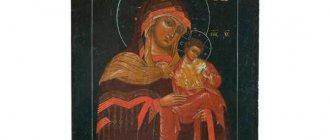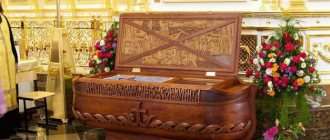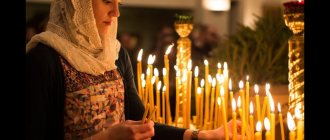Share with family and friends:
This topic is not simple, especially since not everyone understands the deep meaning of entering a monastery. In modern reality, there is also the so-called “Orthodox romance”, which people often, unwittingly, envelop this topic with. Let's try to answer, to the best of our ability, frequently asked questions related to joining a monastery.
Formation of tradition
Who do we call monks? If we consider the interpretation of this word, it means a person living alone. However, such a definition does not indicate the true meaning of this concept. After all, there are a lot of lonely people, but not monks. This word contains something more than human loneliness.
A monk, according to the explanations of the Orthodox Church, is one who is called to constantly do good deeds, to protect himself from sinful impressions and thoughts, steadily following the path of serving God. This is a warrior of the King of Heaven, located on the front line, who cannot retreat or leave the battlefield. After all, behind is God.
It often happens that people who come to the monastery are shocked by the difference that exists between reality and their ideas about this place.
In the monastery life goes on as usual. Of course, it is very different from the secular one, but at the same time it is not as boring and monotonous as one might expect. Here, in addition to prayers, every person is engaged in some activity and is not deprived of communication.
It is believed that the monasteries arose with the advent of Christianity. In Rus', the first of them was the Kiev-Pechersk Lavra. People came here who believed that all the pleasures that exist in their lives distract them from God. This monastery was named Pechersky because all its premises, including cells, were located in natural rock caves.
At the initial stages of its formation, the monastic tradition meant complete asceticism. In other words, people completely violated their desires, as well as their bodily needs. That is why monks and nuns lived in deserts and caves, sleeping on boards or directly on the ground. Often they did not eat food for several days during the week, did not drink wine, and also did not allow themselves any comfort in any of its manifestations. Thanks to such renunciation, as well as constant prayer, God revealed secrets to them and through them worked miracles.
The most famous monastery in Russia is the Trinity Lavra of St. Sergius. In this monastery, miracles, at the command of God, were performed by Sergei of Radonezh and his disciples. One of them is the salvation of Rus' from destruction by the Tatar-Mongol troops, which is believed to have become possible thanks to prayer to the Lord.
How to go to a monastery as a laborer
After you have chosen a monastery, try to go there for a long time, for starters for two weeks (in subsequent times you can increase the time you stay in the monastery up to a month). This means that the excursion option offered by pilgrimage services and travel agencies will not suit you. You will have to get to the monastery on your own.
Having arrived at the place, you must tell the monastery that you have come for so many days - weeks (specify exactly) and want to work for the benefit of the monastery. You can immediately tell what serious illnesses you have (if any) and ask them to take this into account when obeying. But you should talk about this humbly and be prepared for refusal. Although, as a rule, they go to a meeting in the monastery. But sometimes the Lord especially tests those who want to go to a monastery, as if testing the determination of the person being tested!
By the way, everyone can come to labor, not just those who have decided to become a monk. This is generally a godly thing. And many saints said that God blesses people and those families in which they work for the good of the monastery. Father Seraphim, speaking about Diveevo, noted that even those who wipe the dust here receive great grace.
More information about work in Diveevo with accommodation and meals can be found in the article Pilgrimage Center of the Seraphim-Diveevo Monastery
The essence of nuns' lives
It can be explained on the basis of a centuries-old tradition. The essence of monasticism is expressed in four provisions:
- Life in God, which does not involve any relationships and personal connections outside of Him.
- Apostolic life. In this position the nun is seen as the bride of Christ. She is a worker of God. She has no personal aspirations and no children. She is always open to carry out the will of God.
- Cathedral life. This is life in the Church, driven by it, ending in it and belonging to it.
- Spiritual life. It comes from the Holy Spirit. Such a life begins thanks to repentance and faith. Afterwards, she is perfected by the Spirit. This life can be called walking after the Son, and also after Christ in the Spirit, which is directed to the Father.
Based on the provisions described above, the monastic hostel was organized. The women in it try with all their might to fulfill the will of God. Moreover, one of the main conditions for the true inner life of nuns in the monastery is the desire to ensure that their work gets off to a good start.
Serving God
Throughout the history of the Orthodox Church, the choice of the monastic path has been a conscious and serious matter. And at all times he was respected. However, after the revolution in Russia, the tradition of monastic life was difficult to maintain. The new life, in which there was no place for faith, excluded the very possibility of leaving secular life.
In fact, pioneers can be called those people who began to actively join the ranks of monks and nuns at the end of the last century. They knew about faith, as a rule, only from books, but they came to it for the sake of reviving their spiritual life.
A woman must make the decision to enter a monastery herself. However, her spiritual mentor and his God’s blessing help her do this. At the same time, it is worth understanding that life in a nunnery should not be started for the sake of healing those spiritual wounds that were received in the world due to, for example, the death of loved ones or unhappy love. They come to the monastery to cleanse the sinful soul, reunite with the Lord and eternal service to Christ.
Only those who leave nothing in their soul that would connect them with the outside world should begin life in a nunnery. All problems must remain in the past, because the walls of the monastery are not able to save them from them. If a woman has a strong readiness to serve God, then a new life will benefit her. She will certainly find peace and tranquility if she engages in daily work and prayer, feeling that the Lord is near.
The main duty of monks is prayer
Despite the obligatory nature of obedience, it is not the main thing for a monk. The main thing for him is prayer. In the monastery there are three types of prayer:
- Worship.
- Prayer in the cell.
- Prayer during obedience and in free time.
Tatyana Yumasheva.
"Silence". 2005 year. All monks in the monastery must pray. This can be done both during the divine service and in the cell and other places. According to the monastic regulations adopted in most monasteries, any obedience must be completed by the beginning of the divine service.
If this cannot be done, it must be stopped. All monks must attend the service, with the exception of the sick.
There are 3 forms of monk prayer.
In those monasteries where the rules are not strict, the abbot may bless the monk to skip a separate service. This is allowed, for example, when the monastery is small and the brethren have too much work to do.
In any case, the monk will have to pray in another form: at work or in private.
Cell of the Vallam Monastery. Every monk has a vital need - to stand alone in his cell before the Face of the One God.
The cell prayer rule for each monk is determined by the abbot of the monastery or his confessor.
The cell prayer rule for each monk is determined individually by the abbot or confessor. It is performed in the monk's cell, sometimes in solitude. The rest of the time, the monk should also not be idle.
He should read one of the prayers to himself while working or in his free time. Usually monks recite the Jesus Prayer (Lord Jesus Christ, Son of God, have mercy on me, a sinner).
By leaving a comment, you accept the user agreement
Monastery path
Anyone who comes to the monastery is not allowed to take monastic vows right away. A woman will need to undergo a probationary period, which ranges from 3 to 5 years.
This time, as a rule, is enough to take a closer look at life in a nunnery and understand how correct the chosen path is. Before taking monastic vows, you will need to go through several stages. Let's look at each of them.
Trudnitsa
At its first stage, life in a nunnery involves testing one’s intentions to take monastic vows and remain forever in the holy monastery. To do this you need to become a hard worker. This is the name given to women who work in the monastery. They do this voluntarily and for free.
Judging by the reviews, life in a nunnery allows you not to worry about a roof over your head and food. Here, in relation to working women, the word “work” is not used, since, based on the biblical canons, it means “to earn your bread by the sweat of your brow.” The worker does not do this. She serves God.
Judging by the reviews, you shouldn’t count on life in a nunnery just coming from the street. Those wishing to become laborers must undergo a preliminary interview and receive the blessing of the abbot himself, and for some monasteries that accept only churchgoers, also the blessing of the priest.
Drug addicts, alcoholics and smokers are not accepted as labor workers, as well as those who do not have a passport, minors and women who have an appearance inappropriate for a Christian. In addition, each monastery, according to its own charter, also has age restrictions. For example, women from 18 to 60 years old can become workers.
Those who come to the monastery must comply with the internal regulations, customs and rules.
The laborer should remember that in the church hierarchy she is on the very first step. That is why in her life in a nunnery (the photo can be seen below), she must obey the abbot and obey her elders. And if the abbot tells her to leave the monastery, then this will need to be done as soon as possible.
Trudnits are required to attend all services and participate in rituals. Their daily routine when living in a nunnery is such that they devote no less time to prayer than to work.
Working women also have certain restrictions. Despite the fact that they are not yet nuns, they are not given the right to leave the monastery whenever they wish. To do this, you will need to receive a blessing from the abbot.
Also, working women are prescribed to lead an ascetic lifestyle. Unlike nuns, they may have a mobile phone, but frequent use is discouraged. Calls should only be on business and in privacy, so as not to plunge everyone else into the sin of envy.
The whole truth about life in a nunnery may shock a modern person. After all, there is no loud music or outdoor barbecues, TV, radio, and even less so the Internet. Every day begins with getting up at 5-6 a.m. and ends with lights out at 10-11 p.m. There is no quiet time in the monasteries, because idleness is considered a sin.
What kind of work do laborers do in monasteries? These women, as a rule, are laundresses and cleaners, cooks or their assistants, whose responsibilities include peeling vegetables and fish, washing dishes, stirring porridge in a cauldron, and sorting dried fruits and cereals. Workers also work in the garden and vegetable garden. They take care of livestock, flower beds, parks, etc. These women can work in different directions. For example, today weed potatoes, and tomorrow we help in the bakery. Disputes and objections from them are not accepted, otherwise they will have to leave the monastery.
Monastery officials
Mother Superior
1. The abbess is appointed by the ruling Bishop and confirmed in this position by the Holy Synod. 2. According to monastic tradition, the name of the Mother Superior is exalted at all Divine services. 3. She manages all monastic affairs, and therefore must know well all the needs of the monastery in order to have constant care for everything. 4. The abbess is authorized to: conclude and sign contracts, manage funds and material and property assets of the monastery, develop internal rules, use the seal of the monastery and keep it, issue powers of attorney. 5. The abbess, after a certain test, enrolls newly admitted novices among the sisters and expels those who are unable to live in the monastery, bringing her orders to the attention of the ruling Bishop. 6. The duties of the Mother Superior lie in every possible way to maintain high spiritual discipline and good order in the monastery; concern for spiritual work and improvement of nuns; observation of the splendor and regulations of worship in monastery churches; care for the household, the external condition of churches and other monastery buildings. 7. The abbess, as an official and responsible for her monastery, receives various visitors: pilgrims, foreign and domestic guests, employees of church and government institutions, guided in this by good intentions and her own good judgment, which will serve for the good and benefit of her monastery. 8. The main concern of the Mother Superior is to take care of the spiritual state of her sisterhood, their diligence in prayer, in the divine services of the monastery, their zeal in obedience and, especially, in the pursuit of purity and holiness of life. The abbess constantly keeps in touch with the confessors of the monastery and observes how often the sisters begin the Sacrament of Confession and Communion. 9. The abbess, cultivating the will of the nuns, instilling humility in them, checks the fulfillment of the obediences assigned to each of the members of the monastery, and, if necessary, makes comments, and even severe reprimands, even penances, in order to admonish and correct the sinning sister, seeking from her recognition and repentance for the mistakes made. According to St. Basil the Great, nuns must reveal even the innermost secrets of their hearts to the Mother Superior. In a cenobitic monastery, everything that happens must be brought to her attention in order, on the one hand, to convey to the entire internal administration the nature of unity, and on the other, to free officials from the sin of arbitrariness, which burdens the conscience of the novice and causes confusion in the sisterhood. The abbess directly monitors the correctness of the actions of officials and often visits places of general obedience. 10. In the event of absence, illness or death of the Abbess, the treasurer of the monastery takes over the temporary administration of her duties. In exceptional cases, the deputy abbess of the monastery may be another person from the monastery’s Spiritual Council. 11. All officials of the monastery, except for the treasurer, are appointed by the Abbess by written order for the monastery.
Treasurer
1. The Treasurer is appointed by Decree of the ruling Bishop upon the recommendation of the Mother Superior. The Treasurer in his activities is directly subordinate to the Mother Superior. 2. The duties of the treasurer include careful monitoring of the receipts and expenditures of the monastery treasury and maintaining receipts and expenditure books, in compliance with reporting rules. These books are presented monthly to the Mother Superior for review. Prepares an annual report to the Mother Superior for presentation to the ruling Bishop. 3. The treasurer also monitors the condition and movement of all other types of material assets of the monastery. 4. The treasurer maintains an archive of the most important monastic documents, both economic and financial. 5. The Treasurer monitors the condition and storage of inventories of the monastery property and valuables entering the monastery. 6. With the blessing of the Superior, the treasurer gives advance money to the steward and other persons sent for purchases, and demands an account from them. The treasurer is responsible for taking care of the daily needs of the sisters. 7. On the last days of the month, the treasurer, in the presence of three senior sisters, opens the church mugs, counts the money and enters the total amount in the cash book. 8. The keys to the monastery mugs are kept in the treasury. The candle maker, accountant, cashier, and librarian report to the treasurer.
Dean
1. The duties of the dean include supervision over the preservation of external order and moral behavior of the sisters of the monastery, over discipline and their attitude towards their obediences, both in the church and in the monastery. She makes sure that everyone does their work conscientiously at the appointed time. 2. The dean ensures that complete silence and strict order are maintained in the church during the service. For this purpose, he appoints nuns to ensure discipline in the temple. Monitors the correct reading of synodics and notes and commemorations submitted by parishioners at the Liturgy, prayer services and memorial services. 3. In the event of violations of discipline by any of the sisters, the dean gives instructions, admonishing her with a sisterly word. 4. The dean has the right to enter the sisters’ cells in order to know their everyday needs, as well as to monitor the order and cleanliness in them. 5. In order to maintain monastic discipline, the dean must ensure that there are no strangers in the cells of the monastery - even close relatives, meetings with whom can only be allowed in a reception room specially designated for this purpose, and then with the permission of the Mother Superior. Makes sure that the sisters do not unnecessarily visit people staying in hotel cells. 6. The dean will place the monastic guests in the living rooms and take care of them. Obliges workers and pilgrims to obey monastic rules and regulations. 7. Subordinate to the dean are gatekeepers, janitors, church watchmen, and bell ringers. 8. The dean may have an assistant who, in his absence, performs the same functions. 9. The dean reports all violations of discipline among the sisters to the Mother Superior. She daily brings to the attention of the Mother Superior how the sisters spent the day, whether there were any deviations from obedience or deviations from the rules of monastic life. 10. The dean is responsible for the strict observance by the sisters of the monastery of the daily routine of the monastery. Through successive clergy, it satisfies the spiritual needs (demands) of parishioners and pilgrims.
Sacristan
1. The sacristy is under the direct authority of the dean. The duties of the sacristans are the management of church utensils, vestments and all temple property, as well as their careful storage and use for their intended purpose. 2. The sacristan keeps an inventory of all church property and all sacristy items, especially newly received ones, establishing the inventory number, indicating the source of receipt, century, and price. If possible, the history of especially valuable temple relics, icons, and relics is included in the inventory. Vestry valuables should be kept in a safe place. Without the blessing of the Mother Superior, the inventory should not be given out to anyone. Periodically introduce them to the Mother Superior of the monastery for acquaintance. 3. The sacristan must keep the keys to the sacristy and churches. 4. The sacristan, at the direction of the dean, issues vestments for the priesthood and other items of the sacristy, and ensures that items requiring repair or washing are carried out; were corrected and washed in a timely manner, and church utensils were regularly cleaned and wiped down. 5. The sacristan may have one or even two assistants at his disposal, if necessary. Subordinate to her are the ecclesiarch, the tailors of the monastery sewing room, and the prosphora makers. 6. While serving as a sacristan, with the blessing of the Mother Superior, he can purchase the necessary utensils, with subsequent reporting to the treasurer.
Economy
1. The housekeeper is under the direct supervision of the Mother Superior. The responsibilities of the housekeeper include managing and supervising the economic and construction parts of the monastery and supplying the necessary materials. 2. Particularly cares about churches and chapels, as the first shrines of the monastery. The care of the housekeeper extends to the nursing buildings, as well as to all utility rooms. 3. The steward has at his disposal both nuns engaged in monastic economic work and hired workers, whom the steward accepts and assigns at the right time to perform various types of work, coordinating his work plans with the Mother Superior and with her blessing. Subordinate to the housekeeper are: the cellar attendant, the junk attendant, the heads of the workshops, the refectory attendant, the cook, and the buyer. Controls the use of monastery transport. 4. The distribution of time for working sisters depends on the discretion of the Mother Superior or Dean, and the housekeeper only makes sure that everyone works at the appointed time. 5. The allocation of time for hired workers depends on the discretion of the housekeeper, who assigns the necessary work and monitors the quality of its execution. 6. If the steward finds it necessary and useful to make any improvements in the monastic economy, then she is given the right to present her considerations to the Mother Superior, and after approval and blessing she can begin to implement her plans. 7. The steward has a special monastic obedience - to carry out construction and housekeeping work with minimal costs, protecting the monastery treasury, carefully guarding and spending household goods. materials. 8. The housekeeper, if desired and necessary, can have an assistant. 9. The housekeeper receives the right from the monastery to communicate in business matters with government departments. 10. Work on the monastery farm begins and ends in the church way - with prayer.
Kelarsha
1. Kelarsha is under the direct supervision of the housekeeper. The duties of the kelarsha are to purchase the necessary food products, as well as monitor their safety. 2. Under the supervision of the cellar she is the monastery kitchen, food warehouses, prosphora and the refectory, in which cleanliness and tidiness must be maintained. 3. Kelarsha ensures that what is required according to the monastic Rules is always prepared at meals. 4. Without the special blessing of the Mother Superior, the cellar should not release food into the monastic cells. 5. Kelarsha, together with the housekeeper, takes care of the timely preparation of vegetables and fruits for the winter. 6. The following persons report to the Kelarsha: the refectory attendant, the cook, and all kitchen workers. 7. In the absence of a cellar, his assistant, the refectory, replaces him in everything.
Rakhlyadnaya
1. Rakhlyadnaya is under the direct supervision of the housekeeper. Rukhlyadnaya oversees the acquisition and production of shoes or clothing for the sisters, as well as their repair. In her relations with her sisters, a junk woman should be impartial and attentive, for it often happens that one, out of her modesty, does not ask, but needs things, while another demands unnecessary things. 2. New entrants, instead of a cassock, which should be issued only after some time, should be given special black clothes. 3. As for the material from which clothes should be made for the sisters, the material should be bought simple, more durable than sophisticated, and not colored, but black or gray (for cassocks), for ostentation in clothing is indecent to monastic humility.
Instructor
1. The charterer is under the direct supervision of the dean. The responsibilities of the charter member are to strictly monitor the order of all church services, so that they are performed in accordance with the Typikon and local monastic customs. 2. The teacher monitors the daily readers, their correct and statutory administration of the hours, troparions, kontakia, kathismas and other readings, which must be performed without errors, reverently, distinctly and traditionally. 3. Beginners and readers with little knowledge should be taught by the charterer how to read correctly in church. 4. The director must monitor the condition of church liturgical books, and those that have fallen into disrepair must be promptly restored or, with the blessing of the Mother Superior, destroyed if they cannot be repaired. 5. In obedience to the charter are: the regent, the honorary readers and singers. 6. The charterer may have an assistant to whom she must transfer her knowledge and experience.
Regent
1. The duties of the regent are to manage the monastery choir and to establish exemplary order in the choir. 2. The choir must sing harmoniously and prayerfully, so that the singing touches, touches and brings spiritual benefit to all those praying. 3. Neither the regent nor the singers should allow jokes, laughter, quarrels, idle talk and noise in the choir. 4. The regent instructs the canonarch to review the texts of the stichera in advance so that he can canonarch clearly and distinctly, making meaningful stops between phrases. 5. The regent is obliged to systematically organize choir rehearsals, in which all singers must take part. 6. The regent submits to the charterer and coordinates all services with her. 7. The list of chants is submitted to the Mother Superior for approval.
Ecclesiarch
1. The duties of the ecclesiarch are to supervise the service of Altar girls in the Altar and the temple, the cleanliness and neatness of the temple, the timely production of the gospel for church services, the lighting of the altar and the temple, as well as the reverent performance of religious processions and other liturgical processions (burial of the deceased, blessing of water, Easter cakes, fruits). 2. The ecclesiarch is subordinate to the sacristan. The Altar Girls are subordinate to the Ecclesiarch.
Altar girl
1. The duties of an altar attendant require a very attentive attitude towards oneself, since this obedience is associated with her presence in the altar near the Holy See and the Altar, in which idle talk, laughter, jokes and everything indecent to this holy place are unacceptable. The altar server must come to the altar in advance to prepare everything necessary for the service. 2. The altar server is responsible for serving during the divine service, lighting the lamps and censer, preparing prosphora, wine, water, warmth and other things related to the divine service. 3. The altar attendant has the responsibility to look after the cleanliness of the altar and the temple; clean the censer, candlesticks, remove dust and cobwebs from windows, icons, look after the carpets, pour water from the washbasin into a specially designated and arranged place, ventilate and sweep the altar. She monitors the lighting of altars and temples. 4. The duties of the altar server include constant monitoring of the correct reading of the synodics and notes and commemorations submitted by the laity at the Liturgy, prayer services and memorial services. 5. At the end of the service, the altar server carefully checks the altar for fire safety. Usually the altar side doors are unlocked and locked by the altar server herself.
Candle holder
1. The responsibility of the candle maker is to accept donations, memorials, as well as other receipts, which she must hand over to the treasurer.
Zvonarsha
1. The bell ringer rings the bell for the service at the appointed time. 2. Blagovest or trezvon is carried out in accordance with the charter and custom of the monastery. The nature of the ringing must correspond to established traditions. 3. The bell ringer should not allow unauthorized persons into the bell tower without special orders and need. 4. The bell-ringer monitors the condition of the entire belfry.
Clerk
1. The duties of the clerk are to conduct all clerical work of the monastery. 2. All written files of the monastery, including archival ones, must always be in perfect order and properly registered. 3. Correspondence between the monastery and various organizations and individuals should be conducted carefully and not delayed. 4. The scribe accepts the monastic correspondence and presents it to the Mother Superior. She also deals with issues of postal orders, parcels and processes them properly. 5. The scribe may have an assistant who delivers and receives all monastic correspondence at the post office. 6. The scribe reports to the Mother Superior or the treasurer and is guided by their instructions.
Librarian
1. The duties of the librarian include managing the monastery library, acquiring the necessary books, as well as other publications, compiling a catalog and card index. 2. The librarian issues books to the nuns of the monastery, keeping records of who and what was issued. It is not permitted to transfer a book taken from the library to another person. The librarian is obliged to demand the return of the books taken from those leaving the monastery. 3. The position of a librarian requires a person experienced in spiritual work, who would issue books in accordance with the development and spiritual preparation of everyone who wants to borrow a book. 4. The librarian promptly sends damaged books for restoration. Monitors the book depository, monitors its internal conditions and especially fire safety.
Prosphora girl
1. The prosphora maker is under the direct supervision of the dean. The prosphora maker is responsible for the quality and timeliness of making prosphoras, especially liturgical ones. 2. Prosphora is baked from pure, fresh premium wheat flour. 3. The prosphora maker herself must live in purity and reverence, being in prayer, especially while working in the prosphora pan, where outside conversations, laughter, and jokes are unacceptable, since holy bread is being baked for the Sacrament of the Divine Eucharist. 4. The prosphora maker receives flour and everything she needs from the cellar she. 5. The prosphora room is kept in proper cleanliness and order. The housekeeper reports the need for repair work in the prosphora.
refectory
1. The refectory is under the direct control of the housekeeper. The refectory monitors the timely and high-quality preparation of food for the sisters in the cook's room and keeps order during the meal. 2. While eating in the refectory, the lives of the saints, the prologue, or something from the writings of the holy fathers are usually read. The refectory provides this spiritual book to the designated reader and stores it. 3. The refectory every day (or once for the whole week) asks the Mother Superior for a blessing on what food to prepare and in what quantity. 4. At the end of the common meal, in the second place, the refector, the reader and those of the sisters who, being in urgent obedience, did not get to the first place, eat. After the second meal, the refectory does not release food to anyone, unless on the special instructions of the Mother Superior. 5. The refectory monitors that the cleanliness of the room, tables and utensils is always maintained in the refectory. 6. Sets the tables for the sisters' established meal times and then clears away the dishes.
Sick leave
1. The duties of the sick person are to care and supervise those undergoing treatment in the monastery isolation ward. 2. The sick person should be gentle, patient, compassionate and caring towards the sick. 3. The hospital provides patients with food, drink and medicine at the appropriate time.
Hotel
1. The hotel room is subordinate to the dean. Serves those who come to the monastery with the obligatory maintenance of a guest journal according to the established pattern, in accordance with the established procedure. 2. Familiarizes all temporary residents with a signature in the guest register with the following requirements: a/ obey the requirements of the daily routine of the monastery; b/ perform obediences received through the hotel; c/ do not visit the cells of the sisters of the monastery; d/ in case of violation of discipline, leave the monastery upon request. 3. Do not accept for residence without the blessing of the Mother Superior or Dean.
Head workshops
1. The responsibility of the manager of any workshop is to supervise the work carried out in it, as well as the nurses and order in the workshop. 2. Irregularities or abuses must be reported to the Superior.
Novice
If a woman successfully completed the first period, and the difficulties that arose did not frighten her, she must submit a petition to the abbess. After this, she can be transferred to novices. This is the second stage of the life of nuns in the monastery (photo can be seen below), when a woman becomes one step closer to tonsure.
Instead of ordinary clothes, she begins to wear a black cassock. Novices, like laborers, are sent to perform various jobs at the monastery and continue to get used to their new life. The duration of this stage depends on the woman’s behavior. As a novice, she can still leave the monastery if she realizes that she made the wrong choice. She must confirm her readiness to abandon worldly vanity forever with her constant work, as well as humility.
What is monasticism?
Monasticism refers to a whole way of life dedicated to God. Among the clergy, becoming a monk is considered a kind of baptism, which helps a person to be reborn anew and renew his soul. When taking tonsure, a person must renounce his earthly world and move into his holy angelic image. The procedure itself for carrying out this sacred action is very symbolic. A person must make lifelong vows to God. And God must help him cope with his emotional experiences.
Nun
After a woman has gone through the first two stages, the abbess, having become convinced of the authenticity of the novice’s desire to serve God, submits a petition to the bishop. After this, tonsure is performed. At the same time, the woman takes several vows and completely renounces worldly life. She is given a new name.
The life of nuns in a convent is impossible without observing the following ascetic vows:
- Obedience. A nun has no will of her own. She is completely subordinate to the abbess, confessor, and other nuns. A woman who decides to give her life in the name of serving God should not have her own opinion, desire and will.
- Celibacy (virginity). Nuns should not have an intimate life. That is why they never have children or a family.
- Non-covetousness. Nuns are deprived of private property.
- Prayers. Nuns need to pray continuously. The pronunciation of the divine text can be carried out not only out loud, but also mentally.
Small schema or mantle
Being tonsured into the mantle or small schema can be considered the beginning of monasticism. It is at this stage that the candidate makes his vows to God. He completely renounces the outside world, receives a new name and dresses in monastic robes. Usually tonsure into the minor schema is carried out after the ryassophore. But in practice there are various options. Sometimes the ryassophore is skipped and the small schema is immediately carried out. There are cases when a believer immediately accepts the great schema without receiving previous knowledge. Everything here is strictly individual, and is selected depending on the personal qualities and predispositions of the person.
The money tree pleases with lush flowering: my secret is in caring for the leaves
Rare shot: Viktoria Isakova showed her grown-up daughter from Yuri Moroz (new photo)
Lost weight: what Sofia Tarasova sacrificed for the sake of “VIA Gra” (new photos)
Rules of the monastery
Monastic life in a nunnery has a rather strict daily routine. It’s different for each monastery, but in general the daily schedule looks like this:
- getting up early;
- personal prayer;
- saying a joint prayer;
- breakfast;
- performing work in the monastery;
- lunchtime prayer;
- meal;
- completing of the work;
- prayer and service in the temple;
- meal;
- personal time;
- lights out.
As you can see, the life of nuns in monasteries is quite tense. Throughout the day they pray and work. Not every person is able to withstand such busy days in which there is no place for laziness and entertainment.
Schedule of the Vvedensky Monastery
What is it like, the life of nuns in a convent? Each monastery has its own daily schedule of activities. Let's get acquainted with how the life of the nuns goes (photo below) in the Vvedensky Monastery in the city of Ivanovo.
The regime in this monastery can be called gentle. The nuns here get up quite late. Rising in this monastery is at 6 a.m., while in others it can be at 4 or 5 a.m. Women are woken up with a bell. This is done by the night attendant, who can be either a nun or a novice. The attendant walks around all the buildings and all the floors and never stops calling.
At 6:30 a.m. morning prayers begin. These are canons, the midnight office, and also akathists. An hour and a half later, the liturgy begins. At 11.00 all the women go to lunch. There is no breakfast in this monastery, because you cannot eat until the end of the liturgy.
During the meal, as in all monasteries, reading occurs. It changes either to the teaching of the holy fathers, or to a story about a holy holiday. After the meal, the confessor or abbess sometimes conducts a conversation. In addition, the sisters tell the women about the pilgrimage.
At 11.30, right after lunch, everyone goes to work. In the summer, this is usually cultivating the garden. Anyone who wants to know something interesting about the life of nuns in nunneries should know that during such obedience women are allowed to take a player with headphones with them. However, they do not listen to music at all, but to the interpretation of the Holy Scriptures, the teachings and stories of the holy fathers.
At 16:00 everyone gathers for dinner. He is quite early in the Vvedensky monastery. However, the women themselves asked to move it to this time from 20.30. After all, in the evening they practically do not eat, and anyone who feels hungry after the evening service is not prohibited from coming to the pilgrimage meal. It is also allowed to drink tea directly in the cell.
At 5 p.m. Vespers or Matins begins. In the case of the All-Night Vigil, all the nuns gather for prayers. During a regular service, only those women who are free from obedience come to it. Lights out at the monastery is at 11 p.m. However, if women do not have time to do anything, they go to bed later.
Accommodations
The life of nuns in the cell takes place only in their free time from obedience. Here they read books, do handicrafts, and those women who receive higher spiritual or secular education prepare for exams.
The cells are designed for one or two people. And such conditions are quite comfortable, because in the past they housed five or more women. They slept on the floor with mattresses spread out, despite the fact that the room was designed for one person. But previously there simply weren’t enough places for everyone. The cell has everything necessary for a normal life. This is a bed and a wardrobe, a table, as well as a large number of icons.
While in their cells, the nuns can communicate with each other and visit each other. However, talking about any business is not encouraged.
Cell - place of residence of a monk
A monk's room in a monastery is a cell. In Russian monasteries it usually looks like a small room for one or two monks.
It contains a table, chair, bed or hard couch. You can often find an individual iconostasis or a book shelf. In his cell, the monk spends his free time in prayer or reading spiritual books.
Reconstruction of a cell according to the charter of Kirill Belozersky, Ferapontov Monastery. A cell is the place of residence of a monk
Outsiders are prohibited from entering the cell. This is especially true for representatives of the opposite sex. In case of violation of such a prohibition, the owner of the cell may be punished in accordance with the monastic Charter.
Life of the Seraphim-Diveevo Monastery
This monastery belongs to the Nizhny Novgorod diocese and has its own daily routine and way of life. The life of the nuns in the Diveyevo Monastery is no less intense than in the Vvedensky Monastery. Women here get up very early. Already at 5.30 they go to the temple for prayers. Their day begins at 8:00. After breakfast, the nuns go to obedience. Work includes cooking, cleaning the temple and much more. All obediences are distributed based on the capabilities and health of women. At the same time, the monastery does not adhere to the usual 8-hour working day in the country. The whole day for women is work and prayer. Moreover, it is constant, and not only external, but also internal.
Dinner at the monastery is at approximately 20:00, immediately after the evening service. They prepare food in this monastery with prayer. The food here is quite simple, but at the same time very tasty.
In their free time, women can read fiction and spiritual literature, but television is strictly prohibited. At 23:00, according to the rules in the monastery, everyone must go to bed.
Blessing of the confessor
You are not accepted into the monastery without a blessing. Moreover, it is desirable if this is the blessing of your confessor, with whom you have known for many years, or even an elder (generally recognized in the Russian Orthodox Church). As a last resort, you may be sent to the confessor of the monastery that you have chosen for yourself. And as soon as he blesses, so it will be.
By the way, you need to approach the blessing itself with humility, and not rush into the embrasures if it suddenly diverges from your desire. Because we often want one thing, but God’s providence for us is different.
Here some neophytes may be surprised, what could be higher and better than a monastery? If a person chooses this path, then God will definitely bless him through the elder. But we do not know the ways of the Lord. Sometimes it happens quite the opposite: a girl comes to the monastery for a blessing, and the man of God sends her off in marriage.
You can read about one such episode in the life of the holy Venerable Seraphim of Sarov and in the “Chronicle of the Seraphim-Diveyevo Monastery.” Once two women came to Father Seraphim: one, very young, asked for a blessing to get married, and the other, 30 years old, asked for a monastery. But Father Seraphim blessed differently: he sent the young woman to a monastery, and, to her horror, blessed the 30-year-old to marry. Why did this cause such confusion in the older woman? Yes, because in the 19th century, girls who did not get married before the age of 30 were considered old maids, and their chances of starting a family were almost zero. But here everything worked out well for both women, and each was subsequently satisfied with her life.
And in the lives of many saints we learn how people who decided to choose the monastic path received completely different blessings.
In general, it should be noted that people do not go to a monastery just because their personal life has failed - as, alas, can be seen in our time. In the old days, people were not accepted into the monastery if a person was against marriage and family! For marriage is established and blessed by God! And the fact that the ideals of marriage and family values are now being violated in the world is a terrible sin. And monks, especially, should not participate in this sin, disparaging marriage and family.
It’s just that they personally chose the monastic path for themselves, and chose it based on their spiritual needs, where renunciation of marriage is seen not as an end in itself - for this, in general, it is not necessary to leave the world - but as a means and opportunity to devote oneself entirely to God and spiritual life. life.
Workshops in Diveevo
At all times, life placed monasteries in such conditions that they had to provide for themselves. That is why almost all monasteries had workshops that became famous for their products. Diveevo was no exception.
For many years, it operated and continues to operate its own candle workshop and printing house today. But gold embroidery from Diveevo deserves special attention. The works of the nuns of this monastery cannot but amaze with their skill, accuracy and beauty. Women embroider church vestments and icons. They are excellent at embroidery, using silver and gold threads, stones and beads to create their products. This work is quite painstaking and requires a lot of perseverance. That is why women who accepted obedience in this monastery learn not only embroidery, but also the great spiritual science of patience.
Even in pre-revolutionary times, the monastery was known for its painting workshop. It still exists today. On the territory of the monastery there is its own icon-painting workshop, and a children’s art school is open, which everyone can attend.
Caring for nuns
Today, Diveevo has its own clinic, where a dental office is open and operating. By the way, not only nuns are accepted here, but also workers of the monastery. Diveevo has a paramedic on duty 24 hours a day and has its own ambulance. A medical center equipped with the most modern equipment has been opened for the sisters of the monastery.
Diveevo also has its own almshouse. This institution can be called an analogue of modern nursing homes. Elderly and sick nuns who are no longer able to bear obedience are placed here. They are cared for by young women who act as nannies. If necessary, nuns are examined by doctors and prescribed various procedures, which are performed by nurses. A priest comes to the almshouse. Every Thursday, on the second floor in this building, where the house church “Joy to All Who Sorrow” is located, a liturgy is served.
Elderly nuns, as far as their health allows them, continue to read spiritual books and the psalter, as well as pray. They are also preparing for death. Their attitude towards the transition to the afterlife is completely calm. And this is characteristic of all spiritual people. In preparation for death, nuns strive to confess and receive communion.
Buddhist abodes in Korea
Anyone who wants to learn interesting things about the life of nuns in convents should get acquainted with the daily routine of those who do not belong to the Orthodox Church. Quite curious, what is the daily schedule of adherents of the Buddhist faith? The day in such a monastery begins at 3 am. One of the nuns is responsible for getting up even earlier. She should put on ceremonial robes and then begin to softly beat a bell-shaped mokthan instrument made of wood, while chanting sutras. With such Buddhist chants, she must walk throughout the entire monastery territory. The nuns, hearing these sounds, get up and begin preparing for the morning ceremony. They go to the Main Hall to chant after striking the monastery bell, gong, drum and wooden fish.
At the end of the morning ceremony, each woman begins to do her own thing. The students go to the student hall, the senior nuns to the reflection hall, and the workers to prepare breakfast.
The meal at the Korean Buddhist temple begins at 6 am. Breakfast here includes oatmeal and pickled vegetables. After this, the most important part of the day begins. This is the time when the nuns go about their business or meditate.
At 10.30 the nuns gather for chants in the Main Hall. After that they have lunch. Women sing before and during meals. After finishing their meal, the nuns go about their business again until 5 p.m. Dinner follows. About an hour later it is time for chants. At 21:00 everyone in the monastery goes to bed.











